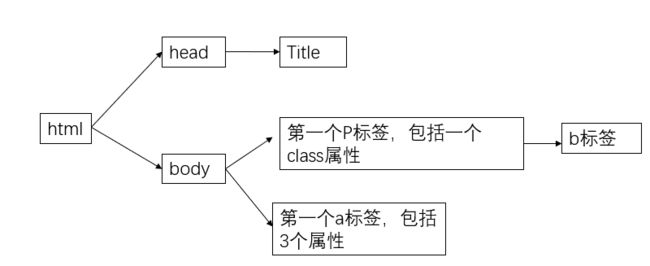一.Beautiful Soup
1.简介
Beautiful Soup 是python的一个库,最主要的功能是从网页抓取数据。其特点如下(这三个特点正是bs强大的原因,来自官方手册)
a. Beautiful Soup提供一些简单的、python式的函数用来处理导航、搜索、修改分析树等功能。它是一个工具箱,通过解析文档为用户提供需要抓取的数据,因为简单,所以不需要多少代码就可以写出一个完整的应用程序。
b. Beautiful Soup自动将输入文档转换为Unicode编码,输出文档转换为utf-8编码。你不需要考虑编码方式,除非文档没有指定一个编码方式,这时,Beautiful Soup就不能自动识别编码方式了。然后,你仅仅需要说明一下原始编码方式就可以了。
c. Beautiful Soup已成为和lxml、html6lib一样出色的python解释器,为用户灵活地提供不同的解析策略或强劲的速度。
2.Beautiful Soup支持的解析器
(1)python标准库(默认):python内置标准库,速度适中,文档容错能力强
使用方法:BeautifulSoup(data, “html.parser”)
(2)lxml HTML 解析器:速度快,文档容错能力强
使用方法:BeautifulSoup(data, “lxml”)
(3)lxml XML 解析器:速度快,唯一支持XML的解析器
使用方法:BeautifulSoup(markup, [“lxml”, “xml”]);BeautifulSoup(markup, “xml”)
(4)html5lib解析器:最好的容错性;以浏览器的方式解析文档;生成HTML5格式的文档;速度慢
二 创建soup对象
下面是官方手册上的一个案例
html_doc = """
The Dormouse's story
The Dormouse's story
Once upon a time there were three little sisters; and their names were
Elsie,
Lacie and
Tillie;
and they lived at the bottom of a well.
"""
(1)导入bs4库
from bs4 imort import beautifulSoup
(2) 创建beautifulsoup对象
此处使用python默认的解析器,即html.parser
soup = BeautifulSoup(html_doc) # 等效于soup = BeautifulSoup(markup, “html.parser”)这样运行的话会出现提醒,如下:
UserWarning: No parser was explicitly specified, so I'm using the best available HTML parser for this system ("lxml"). This usually isn't a problem, but if you run this code on another system, or in a different virtual environment, it may use a different parser and behave differently
To get rid of this warning, pass the additional argument 'features="lxml"' to the BeautifulSoup constructor.
如上提示,避免出现这种提示的话就自己选择一个解析器,如下
soup = BeautifulSoup(html_doc, “lxml”)
格式化输出,有补全功能
result = soup.prettify()
print(result)打印下result,格式化输出
<span style="color:#000000;"> The Dormouse</span><span style="color:#800000;">'</span><span style="color:#800000;">s story</span> 。。。。
三. 四大对象种类
Beautiful Soup将复杂HTML文档转换成一个复杂的树形结构,每个节点都是python对象,所有对象可归纳为以下4中:
Tag ;BeautifulSoup; Comment; NavigableString
(1)Tag
Tag是什么?通俗点讲就是HTML中的一个个标签,例如:
The Dormouse's story
此处的head,title等都是标签,以下为代码运行情况
result = soup.head
print(type(result)) # 打印的结果为
print(result) # 打印的结果为 The Dormouse's story
result = soup.title
print(type(result)) # 打印的结果为
print(result) # 打印的结果为 The Dormouse's story
Tag的两个重要的属性:name;attr
name
print(soup.name) # 打印结果为 [document]
print(soup.head.name) # 打印结果为 title
soup对象本身比较特殊,它的name即为[document],对于其他内部标签,输出的值便为标签本身的名称,如上诉title
attrs
print(soup.a.attrs) # 打印的结果为 {'href': 'http://example.com/elsie', 'class': ['sister'], 'id': 'link1'}
在这里,我们把a标签的所有属性打印了出来,得到的类型是一个字典
如果我们想要单独获取某个属性,如下(以获取href为例)
print(soup.a['href']) # 打印结果 ['http://example.com/elsie']print(soup.a.get('href')) # 打印结果 ['http://example.com/elsie']
(2) BeautifulSoup
BeautifulSoup 对象表示的是一个文档的全部内容.大部分时候,可以把它当作 Tag 对象,是一个特殊的 Tag,我们可以分别获取它的类型,名称,以及属性来感受一下
print(type(soup.name)) # print(soup.name) # [document]
print(soup.attrs) # {} 空字典(3) NavigableString
既然我们已经得到了标签的内容,那么问题来了,我们要想获取标签内部的文字怎么办呢?很简单,用 .string 即可,例如
print(soup.a.string) # 打印结果为 Elsie
print(type(soup.a.string)) # 打印结果为 ,可得其类型 注意:只能获取第一个标签的内容(上面html_doc有多个a标签,但只能获取到第一个标签)
这样我们就轻松获取到了标签里面的内容,想想如果用正则表达式要多麻烦。它的类型是一个 NavigableString,翻译过来叫 可以遍历的字符串
(4) Comment
Comment 对象是一个特殊类型的 NavigableString 对象,其实输出的内容仍然不包括注释符号,但是如果不好好处理它,可能会对我们的文本处理造成意想不到的麻烦。
我们找一个带注释的标签
print(soup.p)
print(soup.p.string)
print(type(soup.p.string))运行结果为:
哈哈
p 标签里的内容实际上是注释,但是如果我们利用 .string 来输出它的内容,我们发现它已经把注释符号去掉了,另外由上诉打印结果可知,它是一个Comment类型,所以,我们在使用前最好做一下判断,判断代码如下
if type(soup.p.string)==bs4.element.Comment:
print(soup.p.string)
上面的代码中,我们首先判断了它的类型,是否为 Comment 类型,然后再进行其他操作,如打印输出。
四. 节点选择器
直接调用节点的名称就可以选择节点元素,再调用string属性就可以得到节点内的文本了,这种选择方式速度非常快。如果单个节点层次非常清晰,可以选用这种方式来解析
上例子的html_doc写成的部分文档树如下(body部分只写出了其2个子节点)
(1)直接子节点(.contents ; .children)
.contents
tag的 .contents属性可以将tag的子节点以列表的方式输出
print(soup.head.contents) # 打印结果为[The Dormouse's story ] 输出方式为列表,我们可以用列表索引来获取它的某一个元素
.children
它返回的不是一个list,不过我们可以通过遍历获取所有子节点,我们打印输出.children看一下,可以发现它是一个list生成器
print(soup.head.children) # 结果
遍历获取里面的内容
for child in soup.body.children:
print(child)
打印结果为
The Dormouse's story
Once upon a time there were three little sisters; and their names were
Elsie,
Lacie and
Tillie;
and they lived at the bottom of a well.
(2)所有子孙节点(.descendants)
.contents 和 .children属性仅包含tag的直接子节点, .descendants属性可以对所有tag的子孙节点进行递归循环,和children类似(也是生成器),我们需要遍历获取其中的内容
for child in soup.descendants:
print (child)
打印结果如下,可以发现,所有的节点都被打印出来了,先生最外层的 HTML标签,其次从 head 标签一个个剥离,以此类推。
The Dormouse's story
The Dormouse's story
Once upon a time there were three little sisters; and their names were
Elsie,
Lacie and
Tillie;
and they lived at the bottom of a well.
The Dormouse's story # 剥离html标签
The Dormouse's story # 剥离head标签
The Dormouse's story # 剥离title标签,进而得到内容,其它类似
The Dormouse's story
Once upon a time there were three little sisters; and their names were
Elsie,
Lacie and
Tillie;
and they lived at the bottom of a well.
哈哈
The Dormouse's story
The Dormouse's story
The Dormouse's story
Once upon a time there were three little sisters; and their names were
Elsie,
Lacie and
Tillie;
and they lived at the bottom of a well.
Once upon a time there were three little sisters; and their names were
Elsie
Elsie
,
Lacie
Lacie
and
Tillie
Tillie
;
and they lived at the bottom of a well.
(3)节点内容(.string)
直接使用当前节点 . string即可获得该节点的内容,但如果一个tag仅有一个子节点,那么这个tag也可以使用 .string 方法,输出当前子节点的内容
print(soup.head.string) # 打印结果:The Dormouse's story print(soup.title.string) # 打印结果:The Dormouse's story
如果tag包含了多个子节点(或多个孙节点),tag就无法确定 .string应该获取哪个子节点的内容,.string的输出结果是None
print(soup.html.string) # 打印结果为 None
(4)多个内容(.strings)
上面讲了获取单个节点内容的方法,那么同时获取多个节点内容的方法是什么呢?
.strings,获取多个内容,但是需要遍历,如下:
for string in soup.strings:
print(repr(string)) # repr 返回规范化的字符串
打印结果为
'\n' "The Dormouse's story" '\n' 'Once upon a time there were three little sisters; and their names were\n' 'Elsie' ',\n' 'Lacie' ' and\n' 'Tillie' ';\nand they lived at the bottom of a well.' '\n'
输出的字符串中若包含了很多空格或空行,可用 .stripped_strings 可以去除多余空白内容
for string in soup.stripped_strings:
print(repr(string)) 打印结果如下(相比前面就少了空行):
"The Dormouse's story"
"The Dormouse's story"
'Once upon a time there were three little sisters; and their names were'
'Elsie'
','
'Lacie'
'and'
'Tillie'
';\nand they lived at the bottom of a well.'
五. 方法选择器
1. find_all( name , attrs , recursive , text , **kwargs )
获取与给定条件匹配的Tag对象列表,可以指定Tag的名称以及希望Tag具有的任何属性。
六. CSS选择器
参考: https://cuiqingcai.com/1319.html
https://cuiqingcai.com/5548.html
https://www.bilibili.com/video/av42741352
